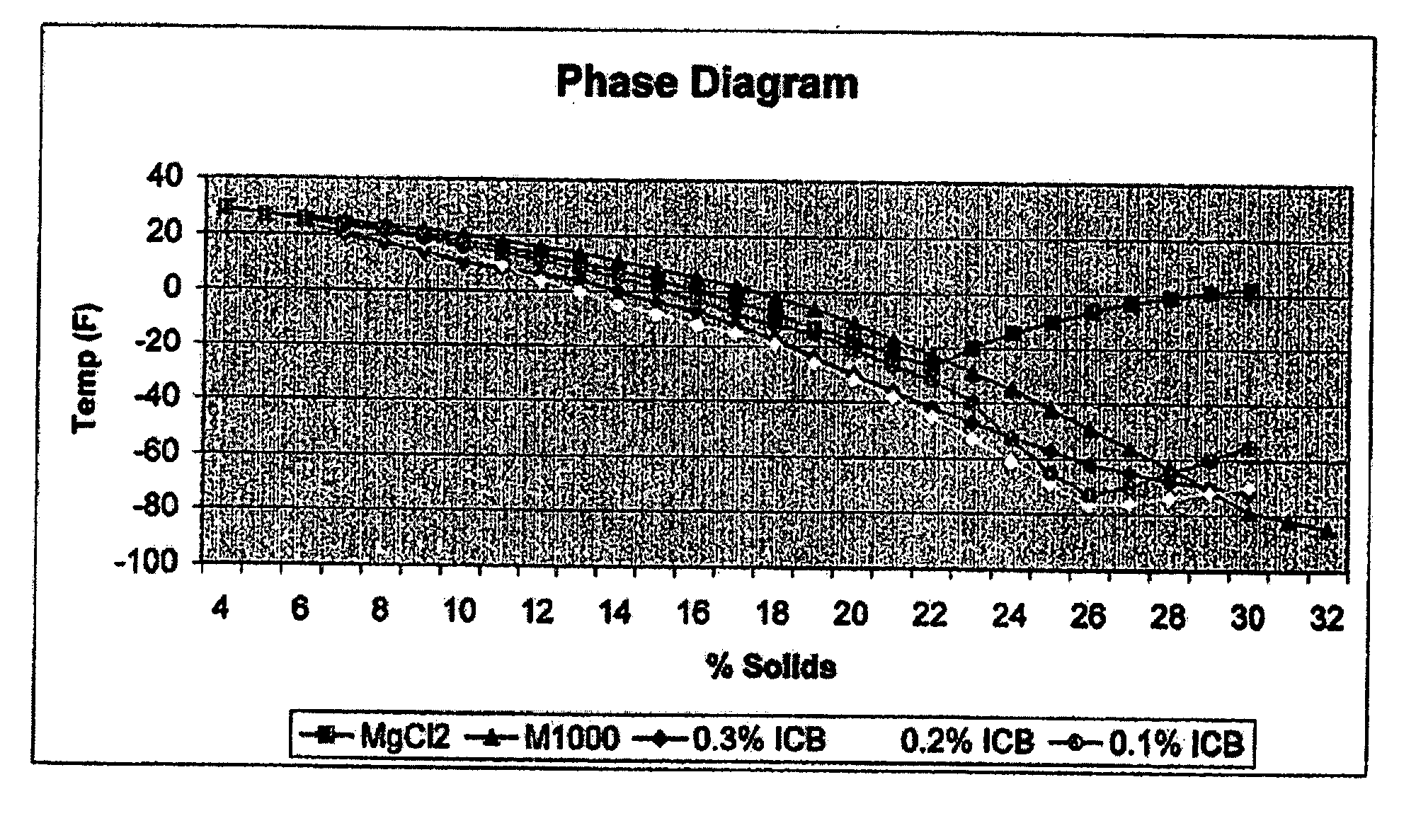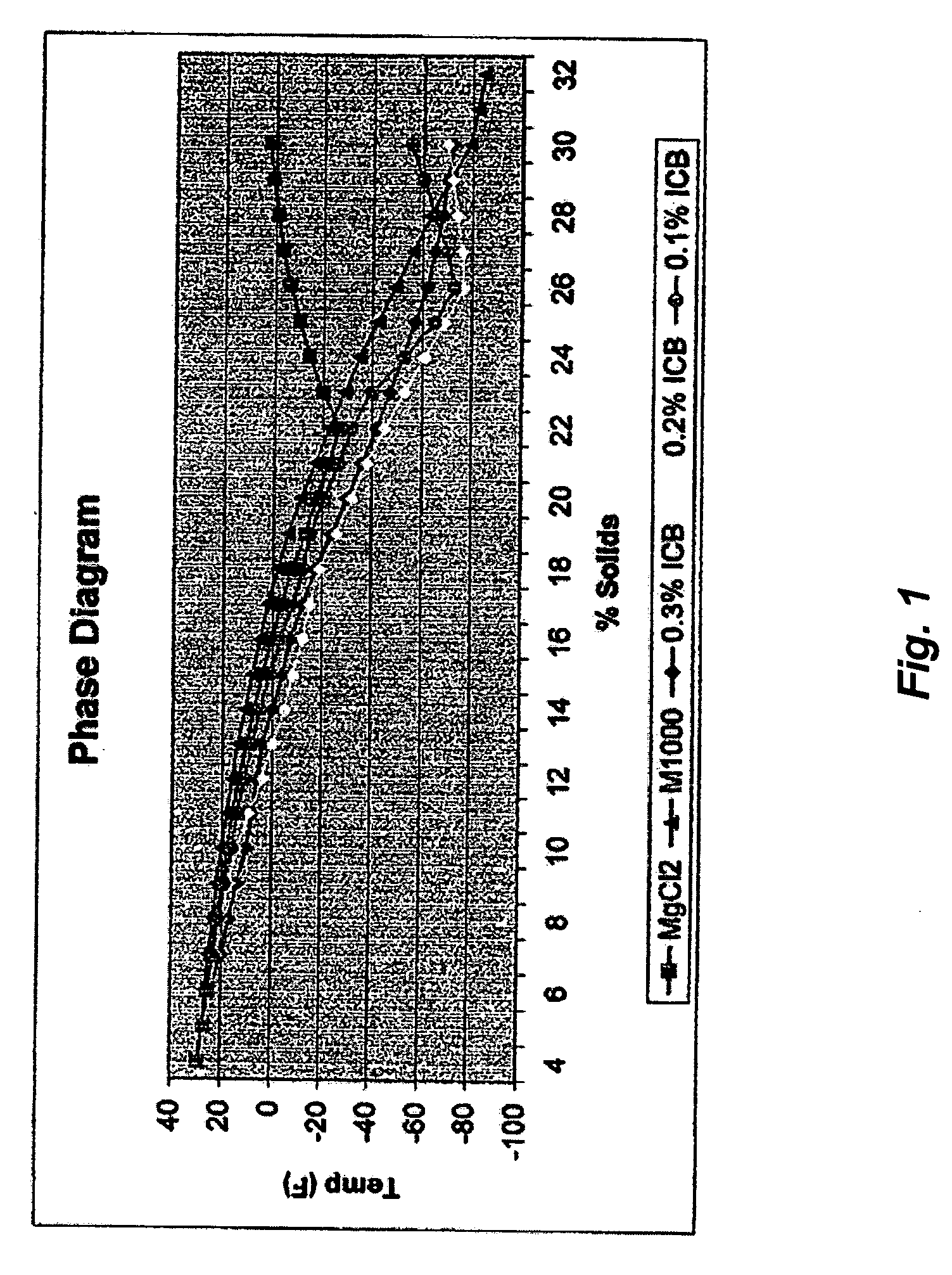Low viscosity de-icing compositions
a composition and low viscosity technology, applied in the field of deicing compositions, can solve the problems of affecting the environment and property, salt dumped on the road can have an adverse impact on adjacent vegetation, and salt migration from the road can be particularly damaging to the surrounding flora and fauna, so as to reduce the accumulation of ice on the surfa
- Summary
- Abstract
- Description
- Claims
- Application Information
AI Technical Summary
Benefits of technology
Problems solved by technology
Method used
Image
Examples
experiment 1
[0026] A starch slurry was formed by adding 10 grams of pearl corn starch to 190 grams of water. The slurry was heated to 190° F. for 15 minutes to gelatinize the starch granules. The slurry was then added to a 30%, wt., aqueous MgCl2 solution in the ratio of 90% MgCl2 solution to 10% starch slurry. After steady mixing with minor agitation, the resulting mixture was 27% MgCl2, and 0.5% starch, with the remainder of the mixture (72.5%) being water.
[0027] Measurements were then taken of the freezing point of water with mixture concentrations of 100%, 75%, 50% and 25% in water. The freezing points were compared with equivalent dilution ratios of a 27% MgCl2 solution, and another de-icing composition of water, MgCl2 and sugars. The results are displayed in Table 1, which refers to mixture prepared above as Formula 1.
TABLE 1Comparison of Freezing Points for De-Icing Compositions27% MgCl2MgCl2 +ConcentrationSolutionsugarsFormula 1100% −3° F.−85° F. −62° F. 75%−17° F. −14° F. −22° F....
experiment 2
[0029] Freezing point measurements were made of mixtures made by adding powdered starch directly to an aqueous 30%, by weight, MgCl2 solution. The powdered starch component was a modified dent corn starch sold under the tradename ICB® 3000D by A E Staley Manufacturing Co. of Decatur, Ill. Comparative measurements were also made with aqueous 18%, by wt., MgCl2 solutions. Table 2 compares the freezing points of compositions with starch concentrations of 1.0%, 0.5% and 0.2%, by wt., mixed with the aqueous 30% MgCl2 solution.
TABLE 2Comparison of Freezing Points for Various Starch ConcentrationsStarch Concentration inFreezing Point ofaqueous 30% MgCl2Freezing Point ofComposition with 18%solutionCompositionMgCl2 solution1.0%−52° F. −7° F.0.5%−60° F.−11° F.0.2%−70° F.−19° F.
[0030] The data show, surprisingly, that compositions with lower starch concentrations have better freezing point depression characteristics.
experiment 3
[0031] Comparative measurements were made of the viscosity of compositions of the invention with pure aqueous 30% MgCl2 solutions, and mixtures of aqueous MgCl2 with sugars. The compositions of the invention included 0.2%, by wt., ICB® 3000D starch combined with an aqueous 30%, by wt., MgCl2 solution. Table 3 shows the viscosity data for the three compositions at various temperatures. The viscosity is measured in centipoises, which is 1 / 100th of a Poise, wherein 1 Poise=0.1Pa×sec.
TABLE 3De-icing Compositions Viscosity Data (Viscosity in Centipoise)ViscosityViscosity of PureViscosity ofViscosity ofAqueous 30% MgCl2MgCl2 +MgCl2 +TemperatureSolutionsugars0.2% Starch 0° F.201152620° F.18602240° F.13401560° F.8209
[0032] The comparative data showed the viscosity of the present de-icing composition were much closer to the aqueous salt solutions than deicing compositions that added sugars. At lower temperatures, where the de-icing compounds are more likely to be used, the difference in vi...
PUM
| Property | Measurement | Unit |
|---|---|---|
| viscosity | aaaaa | aaaaa |
| viscosity | aaaaa | aaaaa |
| viscosity | aaaaa | aaaaa |
Abstract
Description
Claims
Application Information
 Login to View More
Login to View More - R&D
- Intellectual Property
- Life Sciences
- Materials
- Tech Scout
- Unparalleled Data Quality
- Higher Quality Content
- 60% Fewer Hallucinations
Browse by: Latest US Patents, China's latest patents, Technical Efficacy Thesaurus, Application Domain, Technology Topic, Popular Technical Reports.
© 2025 PatSnap. All rights reserved.Legal|Privacy policy|Modern Slavery Act Transparency Statement|Sitemap|About US| Contact US: help@patsnap.com


